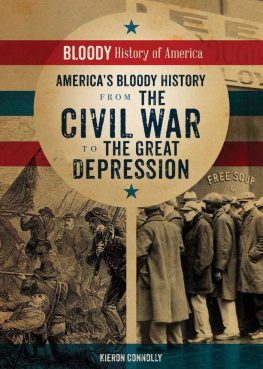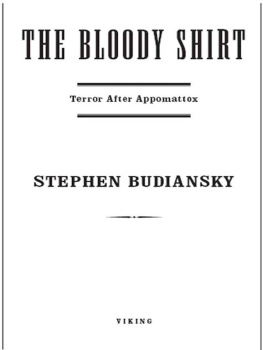This edition published in 2018 by:
Enslow Publishing, LLC
101 W. 23rd Street, Suite 240
New York, NY 10011
Additional end matter copyright 2018 by Enslow Publishing, LLC.
2018 Amber Books, Ltd.
All rights reserved.
No part of this book may be reproduced by any means without the written permission of the publisher.
Library of Congress Cataloging-in-Publication Data
Names: Connolly, Kieron, author.
Title: Americas bloody history from the Civil War to the Great Depression /
Kieron Connolly.
Description: New York, NY : Enslow Publishing, 2018. | Series: Bloody history of America | Includes bibliographical references and index. | Audience:
Grades 7-12.
Identifiers: LCCN 2017031475 | ISBN 9780766091788 (library bound)
| ISBN 9780766095557 (paperback)
Subjects: LCSH: United States-History1865-1921Juvenile literature. |
United StatesHistoryCivil War, 1861-1865Juvenile literature. |
United StatesHistory1919-1933Juvenile literature.
Classification: LCC E661 .C74 2017 | DDC 973.7dc23 LC record available at https://lccn.loc.gov/2017031475
Printed in China
To Our Readers: We have done our best to make sure all websites in this book were active and appropriate when we went to press. However, the author and the publisher have no control over and assume no liability for the material available on those websites or on any websites they may link to. Any comments or suggestions can be sent by email to .
Photo Credits: Cover (left), pp. 3 (left), 6 ivan-96/DigitalVision Vectors/Getty Images; cover (right), p. 3 (right) Everett Historical/Shutterstock.com; Alamy: 10 (Mary Evans Picture Library), 14 (Painting), 29 (Artokoloro Quint Lox), 31 (Paul Fearn), 35 (Niday Picture Library), 50 (NSF), 58 (World History Archive), 62 (World History Archive), 65 (Pictorial Press), 73 (Heritage Images); Alamy/Granger Collection: 37, 39, 49; Amber Books: 27; Getty Images: 46 (De Agostini), 69 (Moviepix); Getty Images/Archive Photos: 11, 36, 61, 74; Getty Images/Bettmann: 42, 68, 71, 76; Library of Congress: 9, 13, 19-25 all, 40, 41, 45, 51, 54, 57 (Dorothea Lange), 59, 63, 67, 77; U.S. Department of Defense: 17, 30, 52.
CONTENTS
Chapter 1
The Civil War
Chapter 2
Freedom and Closing the Frontier
Chapter 3
The New Age
INTRODUCTION
EVEN THOUGH THE UNITED STATES IS A YOUNG COUNTRY, IT HAS A VASTLY complex history. Conflicts and warssome very bloodyhave played a significant part in shaping the United States as we know it today, and they have marked vastly different chapters in the nations development.
The story of the United States from the Civil War to the Great Depression is a particularly gruesome one. It involved the institution of slavery, the harsh penalties for those who tried to escape it, and the segregation that followed once it was finally abolished. This period in history also saw the continued ill treatment of Native Americans and the cruelties they suffered during westward expansion.
Domestic issues were especially prevalent during this time as well. Americans grappled with not only racial conflict, changing legislation, and riots, but also with ends and new beginnings, saying goodbye to the Wild West and hello to the rise of Hollywood with its glamour and sordid tales alike. With all of this going on, the United States still eventually joined World War I, losing thousands of lives even though the war was nearly over by the time American soldiers reached the trenches. Moving forward, the early twentieth century saw more industrialization, environmental disasters, and issues such as Prohibition. Then the stock market crashed in 1929, marking the dawn of the Great Depression and causing both people and institutions economic hardship, the likes of which provide valuable lessons for the United States even today.
CHAPTER 1
THE CIVIL WAR
GIVEN THE LONG-STANDING DIFFERENCES BETWEEN THE NORTH AND South over slavery, it is less remarkable that they eventually went to war than that violent conflict was avoided for so long. But when war did erupt, the conflict would be particularly bloody, with more American lives lost than in both World Wars combined.
In Georgia in 1848, a slave named Ellen Craft cut her hair short, put on mens clothes and, being light-skinned enough to pass for white, posed as a sickly white gentleman heading north for medical treatment. To complete the picture, accompanying him was a black male ser-vantwho was in fact Crafts slave husband, William. In that way, Ellen and William Craft escaped to freedom. Their tale is one of the more remarkable and celebrated regarding fugitive slaves, but throughout the nineteenth century, several hundred slaves a year fled north, assisted by the underground railroad of sympathizers.
The Crafts settled in Boston, where William found work as a cabinetmaker. However, two years after their escape, the Fugitive Slave Bill was passed and the Crafts former slave owner sent two agents to recapture them. With blacks and whites in Boston vehemently opposed to slavery, the Crafts were protected, while the agents were harassed in the streets. After a couple of days, the pursuers gave up. To some this was mob law, and President Millard Fillmore denounced the actions of the Bostonians. Meanwhile, the Crafts friends helped them onto a ship bound for England.
The Crafts had escaped again, but in the 1850s, there were 332 cases of alleged former slaves being forcibly returned to the South. Some had fled north years earlier, but in February 1851, a black man was taken from his wife and family in southern Indiana and returned to an owner who claimed that he was a slave who had run away nearly 20 years before. The burden of proof lay with the man to prove that he was free, not with the agents to prove he was the slave they were seeking. In response to the new law, many people in northern black communities fled across the border to Canadaan estimated 3,000 moving there in 1850 alone.

During the Civil War, the North had a larger population, more industry, control of the US Navy, and more than three times the number of white men of military age. The South, though, had some international support, notably from Britain.
VIOLENT PROTESTS
Civil WarThe First Blow Struck read a headline in a Lancaster, Pennsylvania, newspaper in September 1851more than a decade before the Civil War broke out. The story reported how a slave owner had ventured north to recapture two slaves and had been shot dead on encountering armed resistance from 24 free blacks. To the South, this was an act of insurrection supported by fanatics, and President Fillmore sent in the Marines. Although several arrests were made of both black and white men, charges were later dropped.

Fugitive slave Ellen Craft disguised herself as a sickly white man as part of the escape she and her husband made when they fled to Boston in 1848. When agents were sent to recapture them, the Crafts were protected by free blacks and white sympathizers.

















